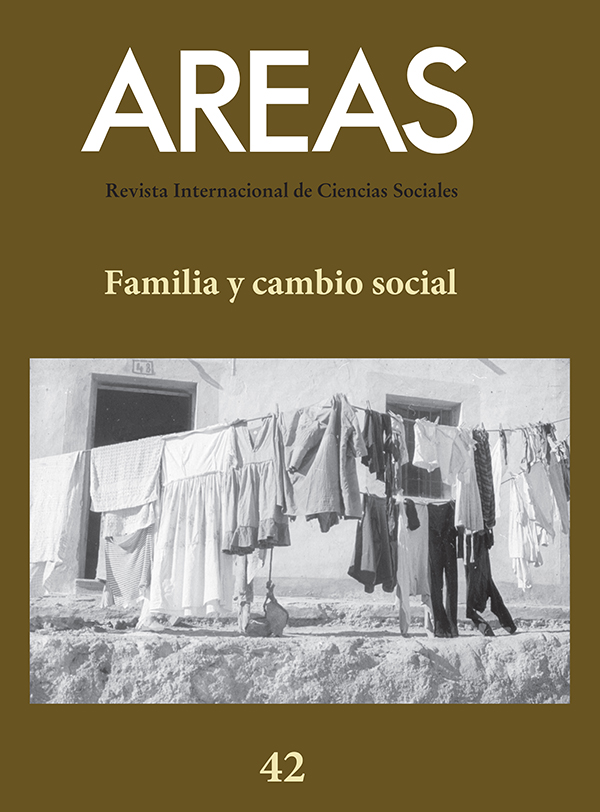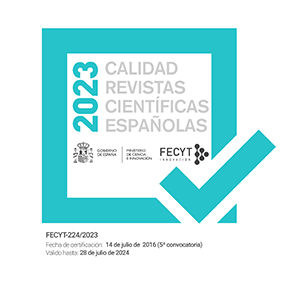Personas mayores, participación y cambio social antes y después del COVID-19
Resumo
La participación social está estrechamente ligada al bienestar y un envejecimiento saludable generando beneficios físicos y psicológicos. Sin embargo, las personas mayores tienen tendencia a bajar los niveles de participación e interacción social tras la jubilación, aunque otros muchos continúan militando y participando en entidades y movimientos sociales.
La pandemia provocada por la COVID-19 ha tenido un fuerte impacto a nivel social y sanitario siendo los principales perjudicados las personas mayores, no solo por las elevadas tasas de mortalidad sino porque las medidas de distanciamiento social impuestas para su protección, han dado lugar a un agravamiento del aislamiento social y el sentimiento de soledad de nuestros mayores. Es urgente generar espacios seguros para aumentar los niveles de participación social.
Downloads
-
Resumo3765
-
PDF (Español (España))2054
-
HTML (Español (España))1302
Referências
AGULLÓ, M. S.; AGULLÓ, E. y RODRÍGUEZ, J. (2002): “Voluntariado de mayores: ejemplo de envejecimiento participativo y satisfactorio”, Revista Interuniversitaria de Formación del Profesorado, 45, pp. 107-128.
AMEZCUA, T. y ABERICH,T. (2020): “Personas mayores: motor de movimientos sociales posindustriales. La marea de pensionistas y jubilados en España y el movimiento Stuttgart 21 en Alemania”, Encrucijadas: Revista Crítica de Ciencias Sociales, 19, pp.1-22.
LAYALON, L.; CHASTEEN, A.; DIEHL, M.; LEVY, B. R.; NEUPERT, S. D.; ROTHERMUND, K.; TESCH-RÖMER, C. y WAHL, H. W. (2020): “Aging in Times of the COVID-19 Pandemic: Avoiding Ageism and Fostering Intergenerational Solidarity”, The Journals of Gerontology Series B Psychological Sciences and Social Sciences, 76 (2), e49-e52. Doi: 10.1093/geronb/gbaa051. PMID: 32296840; PMCID: PMC7184502.
BARTH, J.; SCHNEIDER, S. y VON KANEL, R. (2010): “Lack of social support in the etiology and the prognosis of coronary heart disease: A systematic review and meta-analysis”, Psychosomatic Medicine, 72, pp. 229-238.
BJØRKØY, A. M. B. (2017): “Ageing and dignity”, en P. Andersen (ed.), Literature and honour. Oslo, Universitetsforlaget, pp. 249-274.
BOWLIN, A. y GRUNDY, E. (2009): “Differentials in mortality up to 20 years after baseline interview among older people in East London and Essex”, Age and Ageing, 38, pp. 51-55.
BROOK, J. y JACKSON, D. (2020): “Older people and COVID-19: Isolation, risk and ageism”, Journal of Clinical Nursering, 29, pp. 2044-2046.
CALERO, M. D.; GARCIA, T. M.; GÁLVEZ, M.; TORAL, I. y BAILÓN, R. (1996): “Valoración de un programa de autoayuda entre ancianos: perfil de los voluntarios”, Intervención Psicosocial, 5(13), pp. 85-95.
CAMPAIGN TO END LONELINESS (2011): Safeguarding the Convoy: A call to action from the Campaign to End Loneliness, https://www.campaigntoendloneliness.org/wp-content/uploads/Safeguarding-the-Convoy.-A-call-to-action-from-the-Campaign-to-End-Loneliness.pdf.
CÁRITAS ESPAÑOLA (2009): Voluntariado y personas mayores. Material formativo. Madrid: Cáritas Española Editores.
CHRISTENSEN, K.; DOBLHAMMER, G.; RAU, R. y VAUPEL, J. W. (2009): “Ageing population: in the challenged ahead”, The Lancet, 374, pp. 1198-1208.
COHEN-MANSFIELD, J.; HAZAN, H.; LERMAN, Y. y SHALOM, V. (2016): “Correlates and predictors of loneliness in older-adults: A review of quantitative results informed by qualitative insights”, International Psychogeriatrics, 28 (4), pp. 557-576.
DEL BARRIO, E. (2007): Uso del tiempo entre las personas mayores. Boletín sobre el envejecimiento, IMSERSO, 27.
EDUCO (2015): Informe Crisis y efecto dominó ¿Quedan piezas por caer? El bienestar infantil, abuelas y abuelos en la brecha. Barcelona, Educo.
FAMILY MATTERS INSTITUTE (2009): Do grandparents’ matter? The impact of grandparenting on the wellbeing of children. Bedford, Family Matters Institute.
FERNÁNDEZ-BALLESTEROS, R. (2003): “Una perspectiva psico-social: Promoción del envejecimiento activo”, en Longevidad y vida saludable. Madrid, AECES.
FINGERMAN, K. L.; y TREVINO, K. (2020): “Don’t lump seniors together on coronavirus. Older people aren’t all the same”, USA Today, https://eu.usatoday.com/story/opinion/2020/04/07/coronavirus-seniors-lead-diverse-lives-death-rate-varies-column/2954897001/.
HATTO-YEO, A. (2007): Ageing and social policy: a report for volunteering in the third age. Oxford, Volunteering in the Third Age. The Beth Johnson Foundation
HAVIGHURST, R. J y ALBRETCH, R. (1953): Older people. Nueva York, Longmans Gree.
HAVIGHURST, R. J.; NEUGARTEN, B. y TOBIN, S. S. (1963): “Disengagement, personality and life satisfaction in the later years”, en P. Hansen (ed.), Age with a future. Copenhagen, Munksgoard, pp. 419-425.
HERNANDIZ, S. P.; RUIZ, M. T.; MARTÍ, M. J. y MOLINA, M. B. (2019): “Participación social y satisfacción vital: diferencias entre mujeres y hombres mayores”, Revista de psicología de la salud, 7 (1), pp. 202-234.
HOLT-LUNSTAD, J.; SMITH, T. B. y LAYTON, J. B. (2010): “Social relationships and mortality risk: A meta-analytic review”, PLoS Med, 7(7).
IMSERSO (2008): La participación social de las Personas mayores. Madrid, IMSERSO.
IMSERSO (2011:) Libro Blanco sobre Envejecimiento Activo. Madrid, IMSERSO.
INE (2017): Encuesta continua de hogares. Madrid, INE.
INE (2018a): Estadística del padrón Continuo. Datos provisionales a 1 de enero de 2018. Madrid, INE.
INE (2018b): Encuesta de Población Activa, tercer trimestre, 2018. Madrid, INE.
INE (2021): Avance del Padrón continuo. Resultados Provisionales a 1 de julio de 2020. Madrid, INE.
KELLY, J. (1993): Activity and aging. Staying involved in later life. Newbury Park, CA, Sage.
MCADAM, D.; J. MCCARTHY y M. ZALD. (1999): Movimientos sociales, perspectivas comparadas: oportunidades políticas, estructuras de movilización y marcos interpretativos culturales. Madrid, AKAL.
MEDINA TORNERO, M. E. (2005): Voluntariado y mayores. Murcia, Plataforma del Voluntariado de la Región de Murcia.
MEDINA, E. (2015): Satisfacción e intención de permanencia de personas mayores voluntarias. Uno modelo explicativo. (Tesis inédita), Universidad de Murcia. Facultad de Trabajo Social.
MEDINA, E. MARCOS-MATÁS, G. y MEDINA, M. E. (2016): “Older volunteers´ intention to remain in service in nonprofit organisation”, Psicothema, 28 (3), pp. 272-277.
MINISTRY OF SOCIAL DEVELOPMENT (2001): New Zealand positive ageing strategy. Wellington, New Zealand, Ministry of Social Development.
MIRANDA, A. G.; HERNANDO, L. O.; MARTÍNEZ, A. P.; MORALES, M. M. y OBERGOZO, A. (2006): Envejecimiento activo, envejecimiento en positivo. Logroño, Universidad La Rioja
MORGADO, G. y ROMÁN, M. (2011): “La familia como contexto del desarrollo infantil”, en V. Muñoz y cols. (eds.), Manual de psicología del desarrollo aplicada a la educación. Madrid, Pirámide, pp. 37-60.
NAVARRIO CARRIÓ, M. (2000): Políticas sociales para los mayores en la Comunidad Autónoma de Murcia en Políticas sociales para las personas mayores en el próximo siglo. Murcia, Caja de Ahorros del Mediterráneo-Universidad de Murcia, pp. 159-173
OBRA SOCIAL FUNDACIÓN “LA CAIXA”. (2020): La soledad en las personas mayores: prevalencia, características y estrategias de afrontamiento. Barcelona, Obra Social La Caixa.
PINAZO-HERNANDIS, S. (2020): “Impacto psicosocial de la COVID-19 en las personas mayores: problemas y retos”, Revista Española de Geriatría y Gerontología, 55 (5), pp. 249-252.
POSNER, R. M. (1995): Aging and Old Age. Chicago, University of Chicago Press
RIESCO VÁZQUEZ, E. (2014): La vejez y la política. Participación y potencial político de los mayores en España. Del voto cautivo al poder gris. (Tesis doctoral), Universidad de Salamanca. Salamanca, España.
RUBIO, A. (2004): “Perspectivas teóricas en el estudio de los movimientos sociales”, Circunstancia: revista de ciencias sociales del Instituto Universitario de Investigación Ortega y Gasset, 3, pp. 4-12.
SANTINI, Z.; JOSE, P.; CORNWELL, E.; KOYANAGI, A.; NIELSEN, L.; HINRICHSEN, C. y KOUSHEDE, V. (2020): “Social disconnectedness, perceived isolation, and symptoms of depression and anxiety among older Americans (NSHAP): A longitudinal mediation analysis”, Lancet Public Health, 5, pp. 62-70.
SERRAT FERNÁNDEZ, R. (2016): La participación de las personas mayores en organizaciones políticas: modelos explicativos entrados en el individuo. (Tesis doctoral), Universidad de Barcelona. Barcelona, España.
SHANKAR, A.; MCMUNN, A.; DEMAKAKOS, P.; HAMER, M. y STEPTOE, A. (2017): “Social isolation and loneliness: Prospective associations with functional status in older adults”, Health Psychology, 36 (2), pp. 179-187.
STEPTOE, A.; SHANKAR, A.; DEMAKAKOS, P. y WARDLE, J. (2013): “Social isolation, loneliness, and all-cause mortality in older men and women”, Proceedings of the National Academy of Sciences of the United States of America, 110, pp. 5797-5801.
TANSKANEN, J. y ANTTILA, T. A. (2016): “Prospective study of social isolation, loneliness, and mortality in Finland”, American Journal of Public Health, 106, pp. 2042-2048.
TRIADÓ, M. C. (2003): Envejecer en Entornos Rurales. Madrid, IMSERSO-Estudios I+D+I, 19.
UPD (2013): Voluntariado Social UDP: Tal como somos. Madrid, Unión Democrática de Pensionistas y Jubilados de España (UPD).
VALTORTA, N. y HANRATTY, B. (2012): “Loneliness, isolation and the health of older adults: Do we need a new research agenda?”, Journal of the Royal Society of Medicine, 105 (12), pp. 518-522.
VÁZQUEZ DE PRADA, M. (2005): “Para una historia de la familia española en el siglo XX”, en Memorias y Civilización. Pamplona, Universidad de Navarra, pp. 115-170.
VEGA, J. L. V.; DELGADO, J. B. y MARTÍNEZ, M. B. B. (2002): “Niveles de actividad y participación social en las personas mayores de 60 años”, Revista Interuniversitaria de Formación del profesorado, 45, pp. 33-35.
VICTOR, C. R. y BOWLING, A. (2012): “A longitudinal analysis of loneliness among older people in Great Britain”, The Journal of Psychology, 146 (3), 313-331.
VICTOR, C. R.; SCAMBLER, S. J.; BOWLING, A. y BOND, J. (2005): “The prevalence of, and risk factors for, loneliness in later life: A survey of older people in Great Britain”, Ageing and Society, 25 (6), pp. 357-375.
Las obras que se publican en esta revista están sujetas a los siguientes términos:
1. El Servicio de Publicaciones de la Universidad de Murcia (la editorial) conserva los derechos patrimoniales (copyright) de las obras publicadas, y favorece y permite la reutilización de las mismas bajo la licencia de uso indicada en el punto 2.
2. Las obras se publican en la edición electrónica de la revista bajo una licencia Creative Commons Reconocimiento-NoComercial-SinObraDerivada 3.0 España (texto legal). Se pueden copiar, usar, difundir, transmitir y exponer públicamente, siempre que: i) se cite la autoría y la fuente original de su publicación (revista, editorial y URL de la obra); ii) no se usen para fines comerciales; iii) se mencione la existencia y especificaciones de esta licencia de uso.
3. Condiciones de auto-archivo. Se permite y se anima a los autores a difundir electrónicamente las versiones pre-print (versión antes de ser evaluada) y/o post-print (versión evaluada y aceptada para su publicación) de sus obras antes de su publicación, ya que favorece su circulación y difusión más temprana y con ello un posible aumento en su citación y alcance entre la comunidad académica. Color RoMEO: verde.







